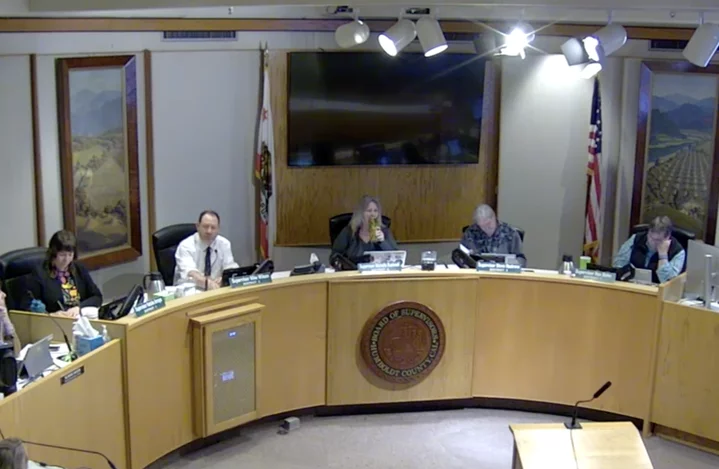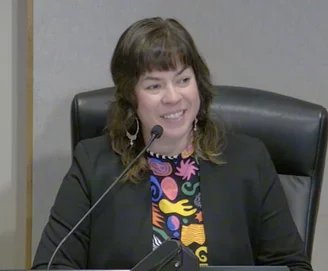The Humboldt County Board of Supervisors. | Screenshot.
###
Most local residents are well aware of Humboldt County’s challenges recruiting and retaining health care providers, but after dealing with medical issues faced by her own family, Fourth District Humboldt County Supervisor Natalie Arroyo decided to dig deeper in hopes of better understanding the problem and identifying potential solutions.
At today’s Board of Supervisors meeting, Arroyo presented a summary of what she learned in recent months by interviewing more than 40 local health care professionals, who provided a more complex picture of the challenges influencing this trend than the simple explanations often proffered. Challenges include our county’s shortage of housing options and clinic space; the burdens of insurance reimbursement and administration; the area’s visible poverty and negative self image; as well as cultural shifts that are impacting the industry nationwide (such as the increasing demand among younger people for a healthy work-life balance).
Arroyo’s presentation was a preview, of sorts, to an upcoming community meeting and panel discussion scheduled for the evening of Jan. 27, when local health care leaders will address our region’s recruiting and retainment challenges and respond to questions from the public.
Working her way through an information-dense slideshow, Arroyo began by noting that there is a nationwide shortage of health care professionals, including not just doctors but also nurse practitioners and physicians’ assistants.
“Within about 10 years, we’re going to be facing a physicist physician shortage in the U.S. of over 85,000 physicians,” Arroyo said, citing a figure from the American Association of Medical Colleges. “That was staggering to me,” she continued, later noting that the shortage is especially pronounced in rural areas.
And yet, Humboldt County is in “much better shape” than many other rural areas, Arroyo heard from her sources.
The health care industry has consolidated dramatically in recent years, with small practices getting subsumed into large conglomerates. Meanwhile, providers are being assigned a larger volume of patients while being forced to spend more time on medical records and note-taking, which was listed among “morale-killers” in the industry. Also on that list: the community’s negative self image and patients who take out their frustrations with the system on their care providers.
“People’s negative talk about Humboldt as a whole came up — that was consistent throughout almost every interview,” Arroyo said. “The overall poor self esteem [in] Humboldt County has this outsized impact on recruitment and retention.”
She added that institutional leadership can also “make or break morale.”
The types of providers who thrive in Humboldt are those who are “mission-driven” and enjoy working solo, as well as those who love the outdoors and have existing connections to the community, Arroyo said.
Recent recruitment efforts include residency programs for family medicine, nurse practitioners and dentistry, and Providence has switched from a regional approach, lumping Humboldt in with Napa and Sonoma counties, to one focused on our county specifically.
Arroyo said that people’s faces lit up when she asked about recruitment, but they were less enthused when she brought up retention. Younger providers, often saddled with enormous student loan debt, often seek modest housing, whereas local landlords have created a “borderline predatory environment of furnished rentals,” Arroyo said, quoting unidentified sources from her interviews.
Our region’s shortage of mental and behavioral health resources — particularly counselors who accept private insurance — has meant that the task has fallen largely on primary care providers, who, in interviews, expressed a lot of gratitude for the region’s existing crisis, residential and post-discharge support for people in poverty, Arroyo said.
Our community has “complex substance use and mental health needs,” and Arroyo noted that, “if people are put off by seeing poor people in the community, they probably won’t do well practicing here.”
Workforce development programs through Cal Poly Humboldt and College of the Redwoods aim to help the region “grow our own” providers, and Arroyo said some of these effort have yet to be announced.
County decision-makers can help address these issues by investing in housing and transportation — particularly air travel — and directing resources upstream toward public health prevention efforts and addressing childhood trauma and other social determinants of health, Arroyo said.
There are limited seats available to attend the upcoming panel discussion in person, but the event will also be live-streamed via Access Humboldt’s YouTube page, and the online audience will be invited to engage via an online polling platform.
Letter on biofuels project
Later in the meeting, the board unanimously agreed to send a letter to the CEO and President of Rural County Representatives of California (RCRC) expressing concerns about a proposed project that aims to convert forest biomass into industrial wood pellet stock for energy production.
This endeavor, dubbed the Golden State Natural Resources (GSNR) Forest Resiliency Demonstration Project, has drawn intense scrutiny and criticism from a range of environmental organizations, partly because of concerns over the potential collaboration with the U.K.-based company Drax, which has a long history of violating air emissions limits.
A few months ago the board of supervisors urged the joint-powers Golden State Finance Authority to extend the public comment period for the project’s the Draft Environmental Impact Report, to no avail. Today, the board approved a letter brought forward by Fifth District Supervisor Steve Madrone outlining a list of environmental concerns, alternatives and recommendations.
Board Chair and Second District Supervisor Michelle Bushnell said the county has received “lots of public comment” on this matter, and more was delivered in person and via Zoom at today’s meeting.
First District Supervisor Rex Bohn, who was involved in developing this project as a member of the GSNR board (an appointment that ended on Jan. 1), said at the outset of the conversation that he’d be voting to approve the letter, even though the biofuels project would provide a big economic boost to Tuolomne and Lassen counties. He advised open communication with the supervisors in those counties.
Speakers during the public comment period, including the leaders of several local and regional environmental organizations, were unanimous in their skepticism of the project and support for the drafted letter. Several said the biofuel project would contribute to environmental pollution and greenhouse gas-fueled climate change. Others said its purported economic benefits have been exaggerated with the help of generous government subsidies.
You can read the full text of Madrone’s drafted letter by clicking here. When the matter came back to the board for discussion, Third District Supervisor Mike Wilson said that while he could “nitpick” some of the particulars, he agreed with the broad strokes of the letter, particularly the call to strengthen the environmental analysis. He also noted that there will be more time to comment when the Final Environmental Impact Report is circulated.
Arroyo proposed a couple of edits to the letter — removing a line about prescribed burns, since none are proposed in the project, and adding a recommendation to consult with local tribes. She made a motion to approve the letter with those changes. Bohn seconded the motion, which passed unanimously.


CLICK TO MANAGE